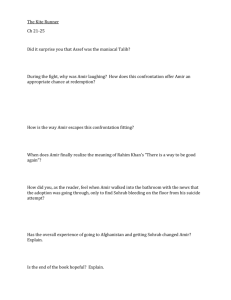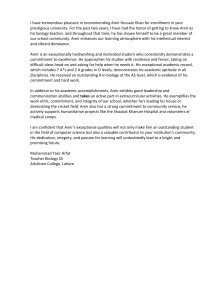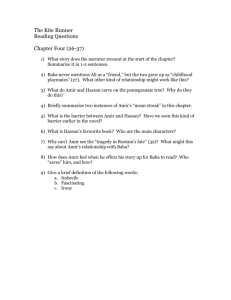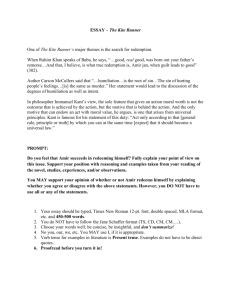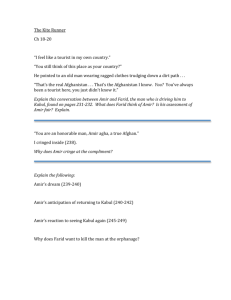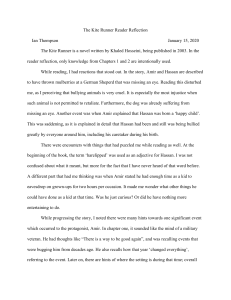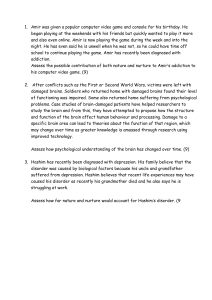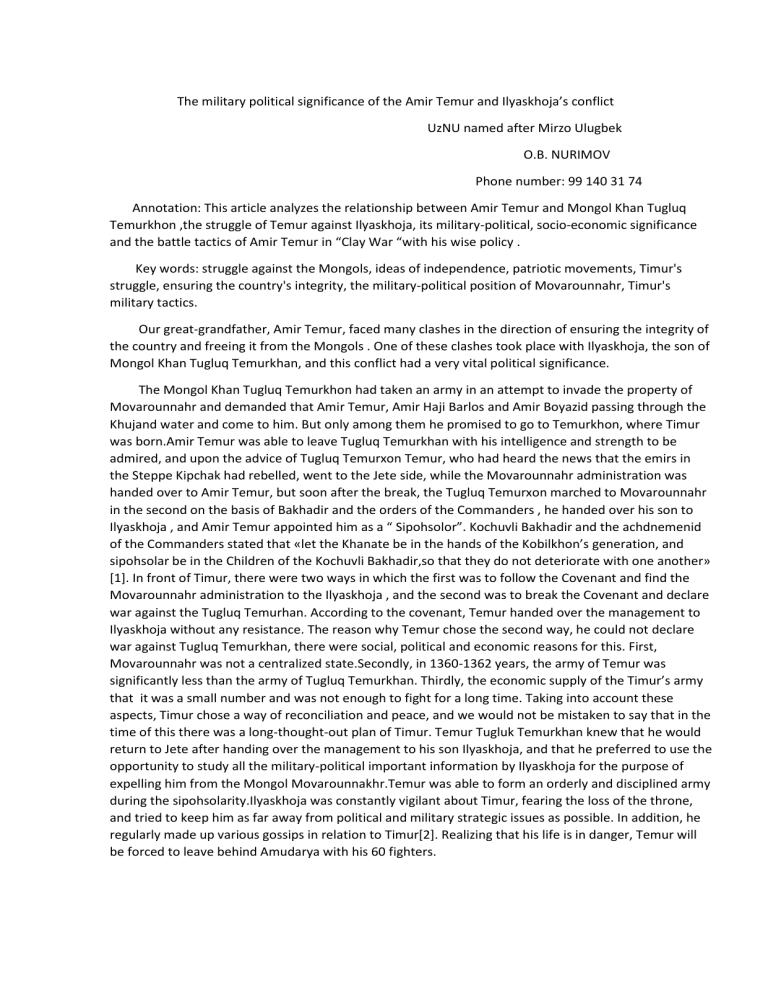
The military political significance of the Amir Temur and Ilyaskhoja’s conflict UzNU named after Mirzo Ulugbek O.B. NURIMOV Phone number: 99 140 31 74 Annotation: This article analyzes the relationship between Amir Temur and Mongol Khan Tugluq Temurkhon ,the struggle of Temur against Ilyaskhoja, its military-political, socio-economic significance and the battle tactics of Amir Temur in “Clay War “with his wise policy . Key words: struggle against the Mongols, ideas of independence, patriotic movements, Timur's struggle, ensuring the country's integrity, the military-political position of Movarounnahr, Timur's military tactics. Our great-grandfather, Amir Temur, faced many clashes in the direction of ensuring the integrity of the country and freeing it from the Mongols . One of these clashes took place with Ilyaskhoja, the son of Mongol Khan Tugluq Temurkhan, and this conflict had a very vital political significance. The Mongol Khan Tugluq Temurkhon had taken an army in an attempt to invade the property of Movarounnahr and demanded that Amir Temur, Amir Haji Barlos and Amir Boyazid passing through the Khujand water and come to him. But only among them he promised to go to Temurkhon, where Timur was born.Amir Temur was able to leave Tugluq Temurkhan with his intelligence and strength to be admired, and upon the advice of Tugluq Temurxon Temur, who had heard the news that the emirs in the Steppe Kipchak had rebelled, went to the Jete side, while the Movarounnahr administration was handed over to Amir Temur, but soon after the break, the Tugluq Temurxon marched to Movarounnahr in the second on the basis of Bakhadir and the orders of the Commanders , he handed over his son to Ilyaskhoja , and Amir Temur appointed him as a “ Sipohsolor”. Kochuvli Bakhadir and the achdnemenid of the Commanders stated that «let the Khanate be in the hands of the Kobilkhon’s generation, and sipohsolar be in the Children of the Kochuvli Bakhadir,so that they do not deteriorate with one another» [1]. In front of Timur, there were two ways in which the first was to follow the Covenant and find the Movarounnahr administration to the Ilyaskhoja , and the second was to break the Covenant and declare war against the Tugluq Temurhan. According to the covenant, Temur handed over the management to Ilyaskhoja without any resistance. The reason why Temur chose the second way, he could not declare war against Tugluq Temurkhan, there were social, political and economic reasons for this. First, Movarounnahr was not a centralized state.Secondly, in 1360-1362 years, the army of Temur was significantly less than the army of Tugluq Temurkhan. Thirdly, the economic supply of the Timur’s army that it was a small number and was not enough to fight for a long time. Taking into account these aspects, Timur chose a way of reconciliation and peace, and we would not be mistaken to say that in the time of this there was a long-thought-out plan of Timur. Temur Tugluk Temurkhan knew that he would return to Jete after handing over the management to his son Ilyaskhoja, and that he preferred to use the opportunity to study all the military-political important information by Ilyaskhoja for the purpose of expelling him from the Mongol Movarounnakhr.Temur was able to form an orderly and disciplined army during the sipohsolarity.Ilyaskhoja was constantly vigilant about Timur, fearing the loss of the throne, and tried to keep him as far away from political and military strategic issues as possible. In addition, he regularly made up various gossips in relation to Timur[2]. Realizing that his life is in danger, Temur will be forced to leave behind Amudarya with his 60 fighters. At such times, the governor of the Balkh region Amir Hussein, will also form an alliance with Temur, according to Ilyaskhoja persecution will establish an alliance with Temur as the situation dictates.The governor of Khorezm, who knows where Amir Temur is walking, attacks Amir Temur with a thousand horsemens as soon as he receives a decree from Tokal Bakhadir Ilyasakhoja about scraping him with his gang .But Amir Temur will succumb to return this attack.Ilyaskhoja's decree on the killing of Amir Temir, sent by the governor of Khorezm Tokal Bahadir, causes an outbreak of conflict between Amir Temur and Ilyaskhoja. When the relationship was determined in this way, Amir Temur began to gather troops in order to fight against Ilyaskhoja . On may 22, 1365 by the Chirchik river there will be a conflict between Amir Temur and Amir Hussein’s union and Ilyoskhoja, known in history as the «Clay War». The war ended with the fully victory of Ilyaskhoja .It was at that time that Timur's battle tactics, which later became very popular, began to take a shape. According to him, ahead of the messengers, between them there was a division of yasovul (chopars), and later a manglay-avangard part.Between Manglay and the main parts of the army, the headquarters of the commander and the reserve parts were located on its side, which were called «izofa».The main combat units of the Amir Temur army consisted of the center,right-Barongor and left-shelf wings.One additional Guard manglay-avangard would be in front of each wing, and by the side one additional Guard warrior would be included. In this way, the army consisted of seven partsarms. It is evident that Amir Temur used the stuffing tactics in the Clay War , which were historically battle methods [3].According to the plan, the army of Amir Temur had to strike the enemy from the right side, and Amir Hussein from the left.Amir Temur with his seven thousand soldiers army , Amir Hussein, on a pallet with a right-hand strike, acting as a winner, does not act according to plan and leaves the battlefield. After that, the plan broke up, Amir Temur began to miss the superiority in the battle and was forced to retreat [4]. The question arises naturally , why did Amir Hussein leave the battle field in pass to the side of Amir Temur, who prevailed at the moment? From a series of comments about this, we can see that the grandson of Kazaghan, who was one of the geniuses of Ghingiz, Amir Hussein, did not want the Mongols to be defeated and the authorities switched to the administration of Amir Temur.The catch of Timur's desire to free Movarounnahr from the Mongols was inextricably linked with the victory of Amir Timur in this battle. After the victory Ilyaskhoja , one after the other, he reassaulted the cities from Tashkent to Samarkand and came to Samarkand with great resistance. The Samarkand people began to dig up against Ilyaskhoja. In the history of this folk movement, which has long been raised against the rule of the Mongols, it finds its fame in the name of the movement of Sarbadors. The sarbadors of Samarkand were headed by the Samarkand, craftsman Abu Bakr Kalaviy and skilful master of rifle Khurdaki Bukhari and head teacher Mavlonzoda . Sarbadors inflict a terrible blow on the Mongolian Ilgar, who first entered the city of Samarkand. At this time, a plague spreads among the horses of the main Mongolian army, which came from behind. Historians have found that this phenomenon occurred approximately in the regions of the present Bulungur District[5]Ilyaskoja , who remained helpless, will have to leave Samarkand and then the whole Movarounnahr and return to Mongolia. This phenomenon creates an opportunity for Amir Temur to quickly restore himself. In conclusion, in the times when these events occurred: First of all, Movarounnahr was extremely weak from a military point of view, the forces with relatively low military potential were in a very difficult situation; Secondly, as a result of the policy of aggression, which the Mongolian authorities carried out tirelessly, the possibilities of entering the area of persons capable of uniting the spread military groups in the country were limited; Thirdly, as a result of the drastic measures of the Mongolians, the level of armament in the country has become extremely strange; From the four, there is no possibility of large-scale military actions, since from the south to the North, a policy of relative Mongol rulers was established on the Lands of Eurasia; From the fifth, the time interval from the invasion of Movarounnahr to the Amir Temur periods, the psychology of the local population was in a very depressed state as a result of the bloody policy of the Mongols conducted here, and this sharply hindered the support of the forces against the Mongols; From sixth, according to the political situation, Movarounnahr was in the center of the regions where the strong armies dominated, and the opportunities for freedom did not allow for economic revival on the basis of international relations. Amir Temur later went on to point out that his «regiments» has been struggling a lot to address these issues. Accordingly, many scientists who analyzed his activities note that even after the creation of the Great Kingdom of Temur, the Turon state was in the Central, middle and border regions, the policy was also accordingly established, and all this Sahibkiran says that he is not only in the World War II, but also a great strategist and politician. Literature: 1.Akhmedov.B. Temur tuzukları-publishing house of literature and art named after Gafur Gulom Tashkent, 1996 2.Marseille.B. Menkim Sahibqiron-Jahongir Timur-new century generation, 2014 y. 3.M.I.Ivanin. О voennom iskusstve i zavoevaniyakh mongolo-tatar I sredneaziyatskikh narodov pri Chingisxane i Tamerlane-new century generation Tashkent, 2018 y. 4. Akhmedov. B. Amir Temur o’gitlari – «Uzbekistan» Tashkent, 2007 5. Azimov. E. Amir Temur Kingdom-literature and art publishing house named after Gafur Gulom Tashkent, 1996
